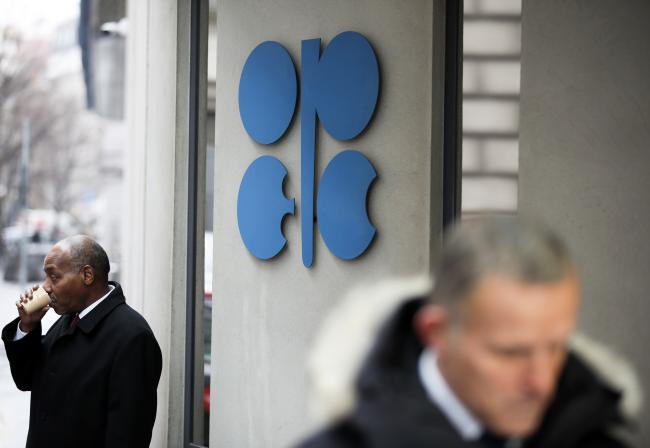(Bloomberg) -- Oil bulls are charging into the new year with unprecedented vigor, and the credit goes to OPEC.
The signs that the group is winning its tug of war with shale are compelling, and money managers have taken note: Their combined bets on rising prices for West Texas Intermediate and Brent crude ended the year at a record. The question now is: Will all that enthusiasm persist for the rest of this year?
“At least through the first half of 2018, they’ll stay pretty bullish,” said Ashley Petersen, lead oil-market strategist at Stratas Advisors in New York. “June will be a real turning point because that’s when we’ll hear about unwinding the deal, and if OPEC doesn’t handle it delicately, then there will be concern that the market will be flooded with oil again.”
The last week of 2017 saw futures trading above $60 a barrel in New York and $67 in London for the first time since mid-2015, after the two most important oil benchmarks surged more than 40 percent from their doldrums in June. The rally came on the back of a well-orchestrated campaign led by Saudi Arabia and Russia to enforce and extend supply curbs implemented by the Organization of Petroleum Exporting Countries and other producing nations.
The effort culminated with a meeting in Vienna in November, where the group and its allies agreed to extend the cuts through the end of 2018. Meanwhile, U.S. crude stockpiles have declined by about a fifth since peaking in March and approached the end of 2017 at their lowest level since October 2015.
While the threat of too much shale production still looms, producers ended the year a lot less gung-ho than they started. Under pressure from investors to focus on profits over growth, explorers have slowed down on drilling with the U.S. rig count stalling in December.
“The expectation is that the rebalance will continue,” Gene McGillian, a market research manager at Tradition Energy in Stamford, Connecticut, said by telephone. “We’ve approached an area where we really need to see a steady diet of positive information.”
The optimism wasn’t so widespread earlier in 2017. Concern that OPEC’s efforts weren’t enough and would end abruptly in March 2018 led short-sellers to dominate the scene for several months, with WTI plunging to the low-$40s in June.
"It really wasn’t until the fourth quarter that we saw a resounding faith in the recovery," Stratas Advisors’ Petersen said.
Global events also swung the market up and down along the way, such as Hurricane Harvey, supply disruptions in Libya and Kurdistan, a pipeline shutdown in the North Sea, and last but not least, a brutal cold snap in the final week of 2017 that drove up demand for heating oil, fuel oil and natural gas.
One of the most remarkable shifts that occurred in 2017, if a very technical one, was the change in the futures curve -- first for Brent and more recently for WTI. Contracts for nearby delivery are trading at a premium to longer-dated ones as demand rises and supplies tighten. This pattern, known as backwardation, hadn’t been seen so consistently since 2014.
Hedge funds boosted their Brent net-long position -- the difference between bets on a rally and wagers on a decline -- by 4.3 percent to a record 561,284 futures and options during the week ended Dec. 26, according to data from ICE Futures Europe. Longs increased 4.3 percent to an all-time high 622,607, while shorts, which reached a nine-month low in November, rose 4.5 percent to 61,323.
The net-long position on WTI increased 7.3 percent to 411,972, according to data from the U.S. Commodity Futures Trading Commission on Friday. That was close to a record set in February. Longs rose by 5.3 percent and shorts fell by 11 percent.
Record Hedging
The net-short position of swap dealers, an indication of hedging, increased for the 11th straight week to a fresh record, according to the CFTC data.
In the fuel market, money managers increased their net-long position on benchmark U.S. gasoline by about 10 percent. Meanwhile, the net-bullish position on diesel rose by 26 percent to a record as the cold snap boosted heating demand.
But all that enthusiasm could start waning this year. Prices for both Brent and WTI will probably be stuck between $40 and $60 a barrel for most of this year as U.S. shale production rises, global supplies remain high and compliance with OPEC-led output cuts falters, Moody’s Investors Service said Tuesday.
WTI fell 0.2 percent to $60.29 a barrel at 12:50 p.m. in New York on Tuesday, while Brent lost 0.6 percent to $66.45 in London.
“Prices will likely remain range-bound, and possibly volatile, on a combination of increasing U.S. shale production, reduced but still significant global supplies, and potential non-compliance with agreed production cuts -- especially if demand growth is more tepid,” Moody’s senior vice president Terry Marshall said in the report.
(Updates with Moody’s comment and oil prices in last three paragraphs.)
